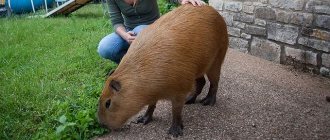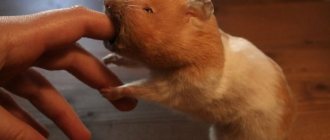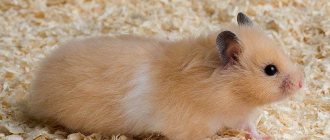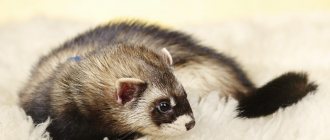Hamsters are small rodents that can make wonderful pets if kept well and properly. There are several breeds of these furry animals. And in this article we will look at all the main breeds of hamsters with photographs and names.
What types of hamsters are there?
Rodents vary in color, size and coat type. There are five types of domestic hamsters in total. Their standards, The National Hamster Council, are set by the National Association of Hamster Fanciers of England.
Syrian hamster
This is the largest Syrian Hamsters from home. The average length of its body is 13 cm. Females are sometimes larger than males.
The classic color of the Syrian hamster is golden brown. There is black ticking on the back - this means that areas of different colors alternate on the hairs. The animal's belly is white with gray undercoat, and there are dark spots on its cheeks.
Individuals of other colors are often found: white, cream, brown, black, gold, silver-gray, striped.
Hamsters of this species can have different coats. There are four types in total:
- Short . The soft fur fits snugly to the body.
- Long . The length of the hairs is from 7.5 to 10 cm.
- Rex . The fur appears tousled.
- Satin . The hair has a glossy shine. It is not recommended to crossbreed two hamsters with such hair, because sometimes the offspring will be bald.
Syrian hamster with classic color. Photo: Olena Kurashova / Shutterstock
Campbell's Russian Hamster
The body length of such a rodent, Dwarf Exhibition Standards, is 10–12 cm. There are three main colors of the animal:
- Normal . The hairs on the back are brown. The belly is white with gray undercoat. The eyes are black.
- Argenta . The top layer of wool is orange-sand, the bottom is smoky-gray. The eyes are red.
- Albino . These are completely white pets with bright pink eyes.
Hamsters with gray, beige, black and chocolate fur are considered non-standard.
Campbell's Russian hamster with normal color. Photo: softkrafts.live.com/Depositphotos
Djungarian hamster
This Dwarf Exhibition Standards animal is sometimes called the Russian white dwarf hamster. Its body length is 8–10 cm. All pets of this species have a black stripe on their backs. There are only three colors:
- Normal . The body is dark brown, with black ticking on a third of the hairs. The paws and belly are white, and the ears are gray.
- Pearl . The rodent's fur is white.
- Sapphire . The fur on the back is smoky gray with a blue tint, the belly is white.
Sapphire colored Djungarian hamster. Photo: Faifarris4746/Shutterstock
Chinese hamster
This rodent looks like a mouse without a long tail. Its body length is 10–12 cm, weight is 45–50 g. There are two main colors of the Chinese Hamster animal:
- Normal . The back and sides are brown with a chestnut tint, the belly is white. A black stripe stretches from the forehead to the tail.
- Spotted . Most of the fur is white. There is an elongated brown spot along the spine.
Albinos with black eyes are extremely rare. They come in litters from spotted parents. But this is the exception rather than the rule.
Chinese hamster with normal color. Photo: alexvey/Shutterstock
Roborovsky's hamster
The smallest of domestic rodents. It weighs only 20–25 g, and its body length is 4.5–5 cm. Typically, these animals have golden-brown fur on their face and back. The roots of the hairs are gray, and there are light spots near the eyebrows. But very rarely there are hamsters with a white muzzle.
Roborovsky's hamster. Photo: Anyarnia/Shutterstock
Syrian
The golden king of children's hearts.
The second most popular species is the Syrian hamster. This species is medium-sized and much larger: the body length is considered to be 12 cm, but there are individuals up to 20 cm tall (this is the largest hamster among pets). The usual color is golden (reddish, peach). Often, for marketing purposes, sellers call this breed Royal, and the name Yellow Hamster is found. Many consider it the most beautiful breed.
There are simply countless decorative colors obtained as a result of selection. The Syrian can be of almost any color, as well as multi-colored.
The character is a little more absurd than that of the Djungarians, but you can tame the Syrian. Females are angrier than males, so we recommend boys for solitary housing. If you are planning to get several Syrian animals, house them separately, even in pairs (only house them for the duration of mating).
They live 3-4 years; long-livers have been known to live up to 5 years.
We have outlined everything you need to know about the maintenance and nutrition of the Syrian breed in this article.
Angora hamster
There is no breed of Angora hamster. This is often the name given to Syrians who are extremely shaggy and have long hair (up to 10 cm). Decorative breed, famous for its fluffiness. The coat requires additional care - keep this in mind if you are planning to get a shaggy hamster.
Golden hamster
Naturally colored Syrians are most often called golden, but there are also representatives of other breeds of this color (for example, tangerine dzhungarik).
What is the character of hamsters?
Rodents are active and curious Providing a Home for a Hamster. Animals are interesting to watch when they play in a cage. If a pet has been accustomed to communicating with a person since childhood, it can calmly sit in your arms. Hamsters rarely bite All About Syrian Hamsters: mainly when they are frightened by a sudden movement. Before communicating, for example, with Syriac, it is recommended to wash your hands. He has poor eyesight, so he relies on smell and touch. If the owner's fingers smell of food, the animal can taste them.
It is not worth keeping individuals in pairs. Even when they live together from an early age, conflicts can arise over time.
If you are still going to buy several animals, it is better to place them in different cages.
Keep in mind that rodents are nocturnal. They sleep during the day, so it is better to play with them in the evening. If you decide to wake up your All About Syrian Hamsters pet, do it very carefully. Talk to him in a gentle voice and lightly rustle the bedding in the cage.
Characteristics of dwarf hamsters
Small breeds of hamsters have their own characteristics. Their body length ranges from 5-10 cm, and their weight is 30-70 g. Each breed has a special coat structure and colors. The average lifespan of dwarf species in the wild is 1 year. At home, animals live 2-3 years.
Small hamsters are very fragile and must be handled with care. The child should be explained that this is not a toy, but a tender and vulnerable living creature.
Small hamsters have poor eyesight, but their sense of smell and hearing are well developed. The animals are fertile and mature early - at the age of 4 weeks they can already mate. In one litter, a female can have from 4 to 8 cubs. They are born weighing from 1 to 2.5 g and look like small worms with tiny legs.
What living conditions does a hamster require?
It is best to house your hamster in a spacious wire cage, Choosing a Dwarf Hamster Cage. The minimum floor area is 60 × 30 cm. A plastic tray is considered a good option. But grated flooring is not suitable: your pet will easily injure its paws on it. The door of the home must close tightly. The distance between the rods is no more than 5 mm. Otherwise, the rodent may escape.
If you choose a multi-level design, pay attention to the height of the floors. The lower they are, the better. Then, when falling, the animal will not be seriously injured.
A pet store may offer you a plastic cage with pipes. Keep in mind: it will not provide adequate ventilation. In addition, it will be difficult to clean.
Hamsters are susceptible to cold and heat. They feel best at a temperature of 18–21 °C The ideal home for your hamster. Therefore, the cage is usually placed away from drafts, radiators and direct sunlight. If the room is too cold, the animal may hibernate. Loud sounds and vibrations cause stress in rodents. Therefore, it is worth finding a calm and quiet place for the house. There should be no TV or music system nearby.
Be sure to place a ceramic bowl inside the cage How to Care for Your Pet Hamster, and pour water into the nipple drinker.
A large layer of bedding should be laid on the pallet of the dwelling. Animals love to rummage in it. If you want to go with wood How to Care for Your Pet Hamster litter, choose aspen. Cedar and pine irritate the respiratory tract of hamsters.
The cage should also have shelter. The pet will rest there. If desired, you can buy a wooden or plastic house. Some owners use cardboard boxes. They wear out quickly, but are easy to replace.
Running wheel without cross supports. Photo: PetroP/Depositphotos
A hamster definitely needs a large running wheel. Try to find something that attaches to the cage. Typically, such models do not have transverse supports on which the animal can damage its paws. If you are a light sleeper, choose a quiet design.
To grind down the teeth that hamsters constantly grow, you will need wooden toys from Pet Hamster Toys. But some owners simply give their pets toilet paper or towel rolls instead.
Roborovsky
Roborovsky are the unique smallest individuals of dwarf hamsters. Adults grow to four to five centimeters. They have long legs and, unlike other hamster breeds, do not have stripes on their spine. Their character is quite active. These are nimble and independent rodents. They cannot sit in one place. It is impossible for Roborovsky to run out of the cage. Then it is very difficult to catch him.
In this article, we tried to tell you about the most popular types of hamsters. All hamsters are interesting in their own way. We wish you to find your pet!
Many pet lovers, before getting such a cute hamster, will definitely find out what colors hamsters come in in order to choose the most suitable option for themselves. However, it is simply impossible to answer this question unambiguously. Indeed, today there are dozens of rodent breeds, each of which has a certain size, hair length and, of course, color. We will tell you about the most common ones so that each reader can decide which breed is right for him.
One of the most common, famous and well-studied breeds. Therefore, many breeders are interested in the colors of Djungarian hamsters. Its natural habitat is Western Siberia, Northeast Kazakhstan, Central and Central Asia. Most often it inhabits steppes and semi-deserts.
In order to reliably hide from dangerous predators, it has a camouflage color - this is the only protection for a hamster in open areas that do not have bushes or other natural shelters. The back has an ocher-gray or brownish-gray color. A little darker on the sides. But the belly is usually light - the border between the dark sides and the light gray belly is clearly visible. On the ridge you can see a narrow black stripe; the snakes are also blackish, although they are almost white on the inside.
Unlike many other breeds that live in milder climates, Djungarians change color depending on the time of year. So, in winter it is almost white, only a silver-gray stripe remains on its back. In summer, the wool is gray, blending well with the dry ground.
What to feed a hamster
The majority of the diet should be prepared food What Can Hamsters Eat? , for example crumbly mixtures. They contain grains, seeds and dried vegetables. The disadvantage is that hamsters pick out the tasty morsels. Less tasty but healthy additives often remain in the bowl. Therefore, you need to make sure that the animal finishes everything. If you have no time to control your diet, it is better to choose granulated food.
Hamsters can also be given human food, but its amount should not exceed 10% of the diet. Here are examples of safe products:
- Vegetables : broccoli, carrots, cauliflower, cucumber, potatoes (cooked), spinach, cabbage.
- Berries : grapes, blueberries, strawberries.
- Legumes : young beans and peas, dry or steamed lentils, unsalted peanuts.
- Fruits : apples (without seeds), bananas.
Animals are also sometimes given hay, dandelion leaves, crickets and mealworms.
You cannot feed your hamster citrus fruits, raw potatoes, apple seeds, dry peas, onions, garlic, almonds, sweet and salty foods.
Peculiarities
The hamster belongs to the order of rodents - these are small animals with short legs and tails, as well as small ears. Despite the fact that there are about 19 species, they are all similar to each other, and differ only in size and color, which depend on their habitat. Thus, the inhabitants of the desert plains received yellow or sandy fur. Hamsters living in the forest-steppe zone got a brown or gray skin. And rocks have black or dark brown fur. This allows tiny animals to safely camouflage themselves from attacks by aerial predators.
Nature has endowed hamsters with sharp and strong teeth - this allows them to cope with hard food such as nuts and grains. The animal has only 4 teeth, which grow throughout its life. Therefore, when kept at home, he needs a special mineral stone on which he will grind his teeth.
The hamster's diet is quite extensive, it includes:
- cereals and legumes;
- vegetables;
- fruits;
- roots;
- herbs;
- berries;
- nuts;
- seeds.
Some species, such as the Transbaikal and rat-like hamsters, also feed on insects and carrion. In the natural environment, a hamster has access to food only in the summer-autumn period, so an animal of any breed will definitely stock up for future use. To do this, he has special cheek pouches that allow him to store food and transfer supplies to storage.
So, we can conclude that a hamster needs a fairly rich diet to provide the body with the necessary elements. As the basis of a pet’s diet, a special food mixture, additionally enriched with vitamins, is perfect. In summer, hamsters need to receive fresh vegetables, fruits, berries and herbs. Suitable for this:
- carrot;
- broccoli;
- radish;
- apples;
- pears;
- apricots;
- strawberry;
- blueberry;
- currant;
- dandelion;
- clover;
- lettuce leaves.
Proper nutrition plays an important role in the well-being of your pet. Under no circumstances should you give your hamster dairy products, sweet baked goods, or certain types of vegetables and fruits. Here is a list of foods prohibited for pet rodents.
- Dairy products (sour cream, yogurt, milk, kefir). They can cause indigestion, which can be fatal for your hamster.
- Flour products (bread, rolls). Such food leads to diseases of internal organs and can cause bloating.
- White cabbage. Its use threatens poisoning and intestinal upset.
- Citrus fruit. Tangerines and oranges can cause allergic reactions and even cancer.
Hamsters are accustomed to getting the required amount of water from food, because in their natural habitat they rarely have access to a water source. However, having a water bowl in your pet’s cage is still necessary. Depending on the air temperature and the food received, the rodent will be able to obtain additional moisture if necessary.
Wild rodents are territorial animals; they live alone in underground burrows. Therefore, two individuals of the same sex will not be able to get along in the same cage. Hamsters are nocturnal. In their natural environment, at night they go in search of food - this way the animal is less likely to fall into the clutches of a predator, such as a weasel or a heron. Be prepared for your pet to spend most of the night spinning the wheel and rustling sawdust.
How to care for a hamster
To keep your pet healthy, you need to regularly clean its cage. Do this in the evening The ideal home for your hamster, when the animal is awake. Dispose of How to Clean a Hamster Cage stale food scraps from bowls every day. Pour clean water into the drinking bowl. Remove feces and wet areas of litter.
If your home looks clean, but it smells bad, you need to replace the filler completely. Sometimes rodents bury food in it, which eventually begins to rot.
Do general cleaning once a week. All you need is a sponge and a non-toxic disinfectant from a pet store. The latter can be replaced with mild hand soap: aggressive chemicals are poison for your pet. When everything is ready, remove the hamster from the cage and place it in a safe place. Don't forget to keep an eye on him. Thoroughly rinse the structure, bowls, running wheel and other accessories. Make sure everything is dry before putting it back in place.
For a comfortable life for a new friend, prepare
1. cage
. Choose a model that is not coated with paint. Hamsters love to chew on metal rods, and the coating applied to the cage can cause poisoning or a chemical burn to the esophagus. The rods must be well welded and have no protruding corners. The optimal distance between them is no more than 1 cm. Check the door for a strong lock.
Important! There are models of cages that include the necessary contents - a house, a drinking bowl, a wheel, a pipe.
2. Filler
. Do not put sawdust in the cage - the animal may get hurt. Choose wood or paper filler. Each type retains odor and is free of toxic substances. The paper version is hypoallergenic, the wood version is difficult to scatter, so it will be clean around the cage.
3. Running wheel
. In the wild, a hamster is able to travel long distances. Physical activity is necessary to strengthen the immune system and prevent the development of obesity. For rodents of large breeds, a wheel with a diameter of 18 cm is suitable, for small ones - 14-16 cm.
4. House
. The little rodent will carry a soft toilet into the house and will sleep, snoring peacefully. The houses imitate the burrows familiar to hamsters, so the pet will hide supplies there. Clean every two days, throw away spoiled food (pieces of vegetables, fruits, herbs). Shelters are made from safe materials - wood, ceramics, plastic.
5. Drinking bowl
. Clean water should be available to the hamster. The drinking bowl should be firmly attached to the cage. Rinse the device before adding fresh water.
6. feeder
. Choose ceramic accessories. They won't be easily turned over, so your pet's food won't end up on the bedding. A small bowl fits in any cage and helps accurately dose food.
Important! In order to save space in the cage, you can choose a product that combines a house, a drinker and a feeder.
7. Toilet
. Hamsters love cleanliness, so they usually urinate in a corner of the cage. Place a plastic toilet filled with pieces of napkins in it. Using the accessory will save time, because the litter will not have to be changed often.
8. Tunnels
. The device helps brighten up a rodent's leisure time when running on a wheel gets boring. Build multi-level structures and labyrinths that will be fun for your pet to move around.
9. Hammock
. Serves as an additional resting place. Hammock houses retain heat, so it’s comfortable to sleep in them if it’s cool at home.
10. Toys
. Wooden models can be moved from place to place and driven around the cage. Textile accessories are durable. The toys are made from safe materials, so don't worry if your pet accidentally swallows a piece.
11. Feed
and
treats
. Specialized foods include a set of ingredients necessary for a balanced diet. Treats containing nutrients supplement the diet. They are also so much fun to chew on!
12. walking ball
. Constant stay in a cage can be diluted with walks in a ball. Thanks to the device, the rodent will calmly travel around the apartment, exploring interesting places.
13. Carrying
. Necessary for transporting the animal. Carrying a hamster in your pocket or bag is dangerous - it can get out of its hiding place and run away.
Source
What do hamsters get sick with?
Hamsters are fragile animals. Any injury or illness can seriously affect your health. You need to know about potential problems at Hamster Health and Diseases in order to take your animal to the veterinarian in time.
Abscesses
These are bumps filled with pus. They form under the skin and mucous membranes and can even appear due to minor cuts or scratches. If your hamster constantly looks like he's got food in his mouth, take him to the vet. There may be an abscess in the cheek pouch. The doctor will remove it and prescribe antibiotics.
Respiratory infections
You can suspect them if the animal sneezes frequently and fluid leaks from the nose and eyes. Problems are also indicated by wheezing, difficulty breathing, loss of appetite and laziness.
Enteritis
Some call this deviation "wet tail." Symptoms include diarrhea, loss of appetite, ruffled fur and lethargy (decreased activity, prolonged sleep). The disease is deadly. It most often occurs in hamsters that have recently been weaned from their mother.
Skin diseases
These are ringworm, fur mites, fungal and skin infections, allergic dermatitis. Take your pet to the vet if he itches frequently. The disorder can also be determined by peeling and redness on the skin.
Diseases
The black rodent, like the white one, is very vulnerable to disease. They are vulnerable to diseases. Stress, hypothermia, poor nutrition and maintenance can lead to weakened immunity of a dwarf pet. As a result, he gets sick.
Signs of the disease:
- begins to sneeze, sniffle;
- refuses food and drink;
- suddenly loses weight;
- eyes fester and water;
- Aggression and increased drowsiness appear.
If you notice these signs in an animal, you should urgently show it to a veterinarian. Remember, self-treatment of a fluffy can aggravate the situation and lead to irreversible consequences.
Reproduction
If a female and a male live in the same cage, then the reproduction of these animals is inevitable and only a matter of time. These animals in captivity can bear huge offspring throughout the year, and young hamsters reach sexual maturity at just 1 month. At the age of 1.5 months, small hamsters can be sent to a new owner.
A female can become pregnant again within a few days after the previous birth.
Determination of gender
The sex of hamsters can be determined by the following characteristics:
- the female is larger than the male;
- the shape of the back: in girls it is more rounded, in boys it is pointed towards the top;
- gender differences: on the 30-35th day after birth, you can identify a boy by his convex testicles, but a girl’s butt will not be smooth, without bulges;
- the female has nipples.
Caring for a pregnant female
A pregnant female should be provided with special care:
- provide regular access to food and water;
- take walks outside the cage several times a day;
- control the stability of humidity and air temperature;
- in the late stages of pregnancy, you cannot pick up the female;
- feed foods that contain large amounts of protein and calcium;
- Before giving birth, disinfect the cage and place soft bedding on the bottom.
Newborn care
To provide newborn hamsters with proper care, you should follow some rules:
- do not disturb the mother and her children when changing water or food;
- The newly-made family should be kept away from children, TV and other animals;
- In the first two weeks, it is absolutely forbidden to pick up newborns;
- During this same period, you should also not clean the cage;
- the room temperature should be 21 degrees;
- it is necessary to provide the female with proper nutrition.
Neoplasms, tumors
Tumors (malignant, benign), pathological growths on the body, legs. ears is a fairly commonly diagnosed pathology in rodents, which can develop for a variety of reasons. Bumps can appear due to injuries, severe bruises, or falls from a height. To begin treatment, you need to establish a diagnosis, so take your pet to a veterinarian.
For benign and malignant tumors, surgical treatment will be prescribed. If the cancer is localized in a hard-to-reach area (oral cavity), or the tumor has metastasized, veterinarians recommend euthanizing the hamster, since no treatment method will give the desired result.
Feeding
Diet
Hamsters' food should be chosen based on the type of rodent. For example, Djungarian hamsters should be given vegetables and fruits, since these steppe animals are accustomed to juicy food. But Syrian hamsters like grain foods - seeds, wheat, corn or oats.
So, a hamster’s diet should include the following foods:
- fruits - these can be pears or apples;
- vegetables – pumpkin, cucumber, tomato;
- grain – millet, watermelon seeds, oats;
- greens - oat sprout, wheat sprout, beet leaves.
In winter, it is worth adding vitamins to your main diet.
Feeding rules
You should feed your pet twice a day, morning and evening. The evening “dish” should be higher in calories than the morning one. Since these rodents love to stockpile, their bowl may often be empty, but this does not mean that the animal has eaten everything. Food may simply be hidden away. For this reason, portions should not be made very large, then the amount of hamster reserves will decrease.
Prohibited Products
The following are prohibited products:
- sweets - all products containing sugar are harmful to the health of the hamster;
- salt-containing products, as well as products containing spices;
- exotic fruits – cause allergies;
- fatty, fried or smoked foods;
- any fermented milk products;
- garlic, onions, mushrooms;
- pasta and pasta.
Watering
Like any living creature, a hamster needs water. Since in a cage he does not obtain water for himself, the owners must take care of this.
There are three ways to water these animals:
- Give bread soaked in water/milk. However, the disadvantage of this method is that such bread will very soon begin to deteriorate, as a result of which it is necessary to replace the litter quite often.
- Give juicy fruits, vegetables, juice that the pet can quench its thirst.
- Give water using a drinking bowl.











